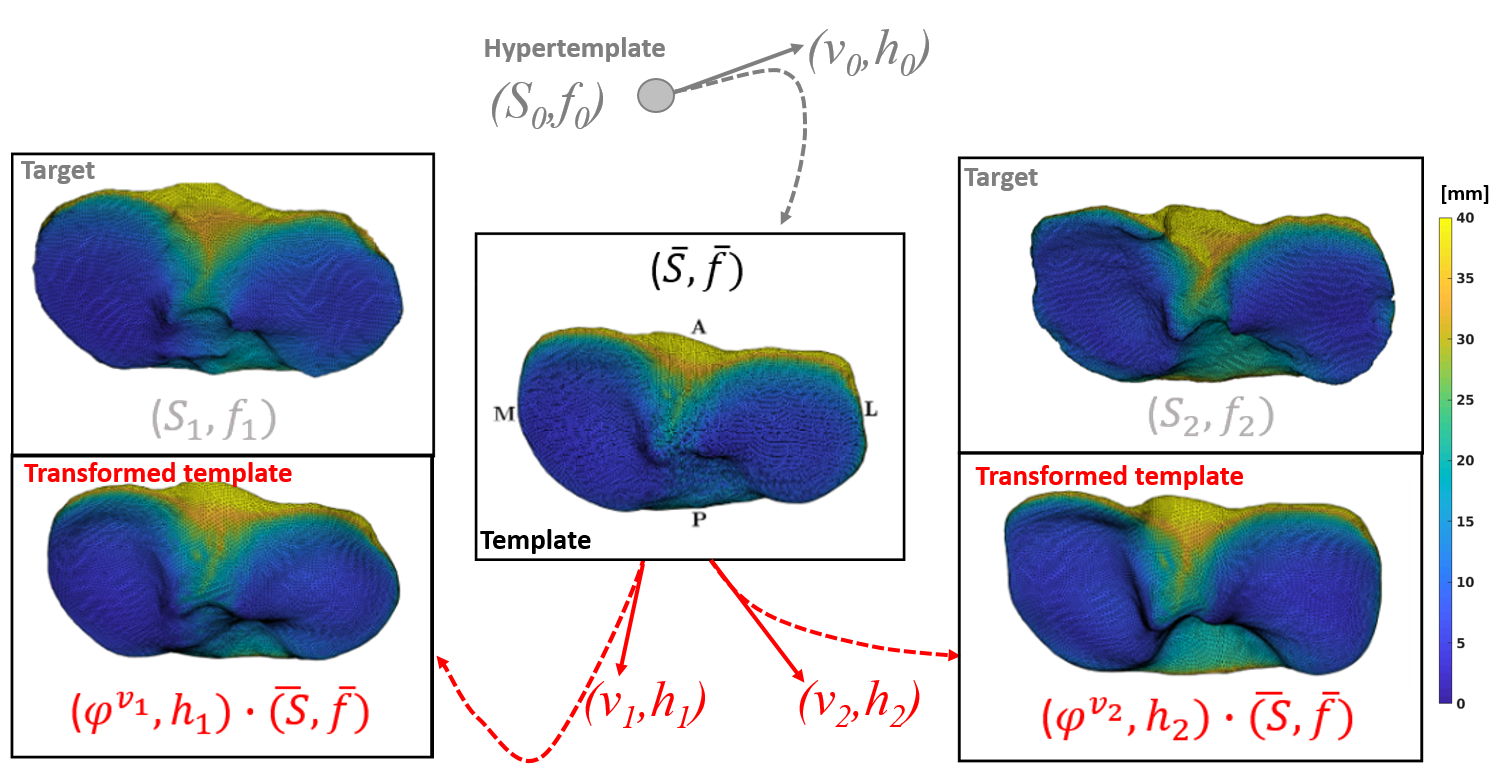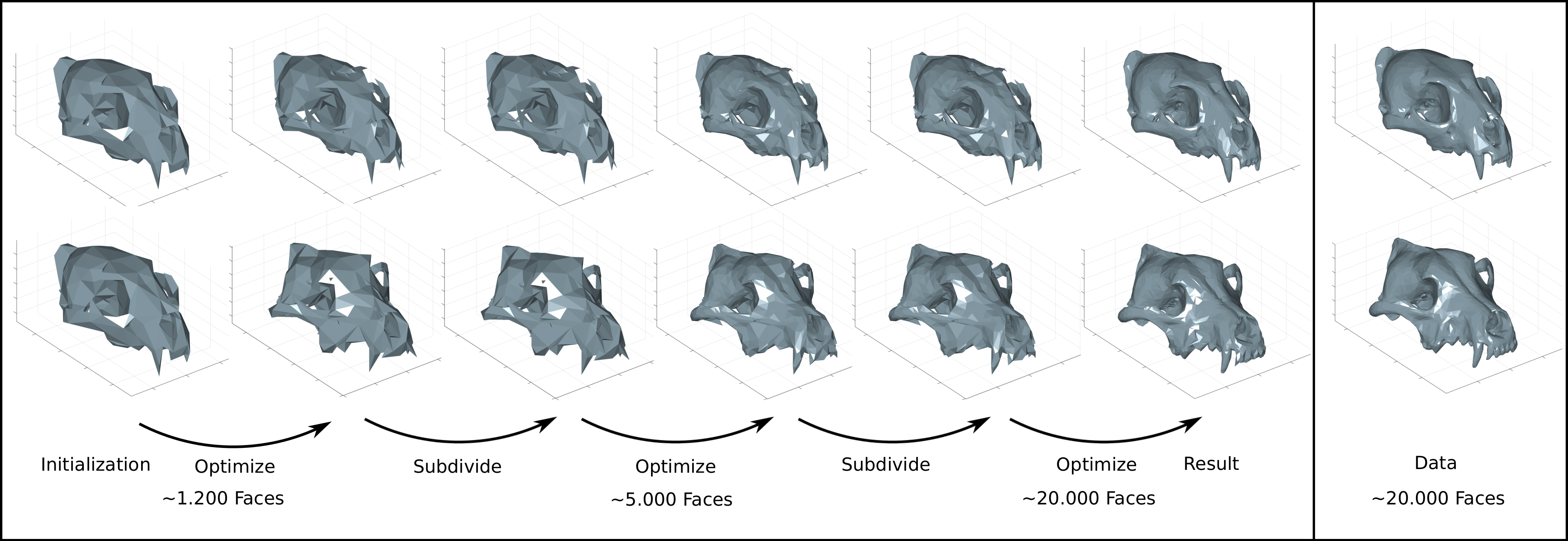Constructing modular mathematical representations and metrics on shape spaces which can be conveniently paired with deformation models is a key component of efficient formulations and algorithms of the registration problem, where one is interested in estimating an optimal diffeomorphic deformation between two given shapes. Several of my past and recent works have focused on concepts and methods originating from geometric measure theory , in particular the framework of varifolds .
Selected papers:
The varifold representation of nonoriented shapes for diffeomorphic registration. N. Charon and A. Trouvé. SIAM journal on Imaging Sciences vol.6(4), 2547-2580. (2013)
ArXiv version
A general framework for curve and surface comparison and registration with oriented varifolds. I. Kaltenmark, B. Charlier and N. Charon. Computer Vision and Pattern Recognition (2017)
Metrics, quantization and registration in varifold spaces. H-W. Hsieh and N. Charon. Foundations of Computational Mathematics vol.21, 1317-1361. (2021)
ArXiv version
Many data structures, in particular the ones acquired through recent medical imaging devices, involve both a geometric component (shape of the underlying structure) with functional information either directly measured (functional response of the brain in fMRI for instance) or reconstructed a posteriori (estimates of the tissue thickness or density...). This specific type of objects calls for new analysis tools that can adequately model and estimate the joint variability in anatomy and function. A potentially promising model is the one of functional shapes (Fshapes) and metamorphoses of functional shapes that was introduced to that end.
Selected papers:
The fshape framework for the variability analysis of functional shapes. N. Charon, B. Charlier and A. Trouvé. Foundations of Computational Mathematics vol.17(2), 287-357. (2017)
ArXiv version
Metamorphoses of functional shapes in Sobolev spaces. N. Charon, B. Charlier and A. Trouvé. Foundations of Computational Mathematics vol.18(6), 1535-1596. (2018)
ArXiv version
Landmark-free morphometric analysis of knee osteoarthritis using joint statistical models of bone shape and articular space variability. N. Charon, A. Islam and W. Zbijewski. Journal of Medical Imaging vol.8(4), 044001. (2021)
Intrinsic Riemannian metrics and in particular elastic metrics between curves or surfaces are constructed as metrics on spaces of parametrization functions quotiented by the group of remarametrizations. Calculating those metrics and the associated geodesics in practice usually involves solving an intricate optimization problem over reparametrizations. In several works, we have explored altenative relaxed variational formulations of such problems and proposed new numerical methods extending the scope of those metrics.
Selected papers:
A relaxed approach for curve matching with elastic metrics. M. Bauer, M. Bruveris, N. Charon and J. Moeller-Andersen. ESAIM: Control, Optimisation and Calculus of Variations vol.25, 72. (2019)
ArXiv version
A numerical framework for elastic surface matching, comparison, and interpolation. M. Bauer, N. Charon, P. Harms and H-W. Hsieh. International Journal of Computer Vision vol.129, 2425-2444. (2021)
ArXiv version
A new variational model for shape graph registration with partial matching constraints. Y. Sukurdeep, M. Bauer and N. Charon. SIAM journal on Imaging Sciences vol.15, 261-292. (2022)
ArXiv version
Diffusion MRI (dMRI) is a particular modality of MRI that can retrieve the diffusion patterns of water molecules within organs. It is of special importance in the study of the brain as it allows to extract the fibers in the white matter and understand the connectivity between the different areas. One important challenge is the very large size of raw dMRI signals and the lengthy acquisition time that it involves on scanners. For this reason, there has been continued interest in the study of sparse representations and applications of the ideas of compressed sensing to the situation of dMRI data.
Selected papers:
Joint spatial-angular sparse coding for dMRI with separable dictionaries. E. Schwab, R. Vidal and N. Charon. Medical Image Analysis vol.48, 25-42. (2018)
ArXiv version
Global optimality in separable dictionary learning with applications to the analysis of diffusion MRI. E. Schwab, B. Haeffele, R. Vidal and N. Charon. SIAM journal on Imaging Sciences vol.12(4), 1967-2008. (2019)
ArXiv version

